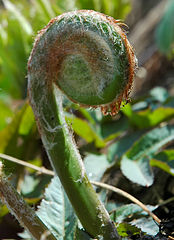
Summary
Osmunda japonica (syn. Osmunda nipponica Makino), also called Asian royal fern[1] or fiddlehead, is a fern in the genus Osmunda native to east Asia, including Japan, China, Korea, Taiwan, and the far east of Russia on the island of Sakhalin. It is called gobi (고비) in Korean, zenmai (ゼンマイ; 薇) in Japanese, and zǐqí or juécài (紫萁 or 蕨菜) in Chinese.[2]
| Osmunda japonica | |
|---|---|

| |
| Sterile frond | |
| Scientific classification | |
| Kingdom: | Plantae |
| Clade: | Tracheophytes |
| Division: | Polypodiophyta |
| Class: | Polypodiopsida |
| Order: | Osmundales |
| Family: | Osmundaceae |
| Genus: | Osmunda |
| Species: | O. japonica
|
| Binomial name | |
| Osmunda japonica | |
It is a deciduous herbaceous plant which produces separate fertile and sterile fronds. The sterile fronds are spreading, up to 80–100 cm tall, bipinnate, with pinnae 20–30 cm long and pinnules 4–6 cm long and 1.5–2 cm broad; the fertile fronds are erect and shorter, 20–50 cm tall.
It grows in moist woodlands and can tolerate open sunlight only if in very wet soil. Like other ferns, it has no flowers, but rather elaborate sporangia, that very superficially might suggest a flower, from which the alternative name derives.
Like its relative Osmundastrum cinnamomeum ("cinnamon fern"), the fertile fronds become brown-colored and contain spores. The sterile (vegetative) fronds resemble those of Osmunda regalis ("royal fern"), another relative of O. japonica.
In some parts of China, Tibet, and Japan, the young fronds or fiddleheads of O. japonica are used as a vegetable.[3] In Korea too, these young shoots are commonly used to make dishes like namul.[4]
O. japonica has also been shown to improve indoor air quality by significantly reducing of air toxins, specifically formaldehydes.[5]
-
 Young frond in spring
Young frond in spring -
 Young plant
Young plant
References edit
- ^ Korea National Arboretum (2015). English Names for Korean Native Plants (PDF). Pocheon: National Arboretum. p. 556. ISBN 9788997450985. Archived from the original (PDF) on 25 May 2017. Retrieved 6 December 2016 – via Korea Forest Service.
- ^ "Osmunda japonica". Germplasm Resources Information Network. Agricultural Research Service, United States Department of Agriculture.
- ^ Dion, C; Haug, C; Guan, H; Ripoll, C; Spiteller, P; Coussaert, A; Boulet, E; Schmidt, D; Wei, J; Zhou, Y; Lamottke, K (2015). "Evaluation of the anti-inflammatory and antioxidative potential of four fern species from China intended for use as food supplements". Natural Product Communications. 10 (4): 597–603. doi:10.1177/1934578X1501000416. PMID 25973486. S2CID 8419285.
- ^ Pratt, Keith; Rutt, Richard (2013), Korea: A Historical and Cultural Dictionary, Routledge, p. 310, ISBN 9-781-1367-9400-1
- ^ Claudio, Luz (October 2011). "Planting Healthier Indoor Air". Environmental Health Perspectives. 119 (10): a426–a427. doi:10.1289/ehp.119-a426. ISSN 0091-6765. PMC 3230460. PMID 22069776.
External links edit
- "Osmunda japonica". Plants for a Future.
- Flora of Taiwan: Osmunda japonica
- Eating from the wild: diversity of wild edible plants used by Tibetans in Shangri-la region, Yunnan, China




